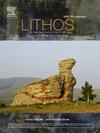Continental crustal growth and thickness changes caused by the Paleo- to Neo-Tethys Ocean transition: Evidence from the Early Jurassic magmatism in the Lhasa terrane
IF 2.9
2区 地球科学
Q2 GEOCHEMISTRY & GEOPHYSICS
引用次数: 0
Abstract
The Late Triassic–Early Jurassic is a significant period for the evolution of the Paleo-Tethys to Neo-Tethys Ocean on the Tibetan Plateau, which includes complex geological processes of Tethys Ocean plate subductions and continent-arc-continent collisions. It is also an important period for the formation and evolution of the crust of many terranes (such as the Lhasa and South Qiangtang terranes) in the Tibetan Plateau. As a probe to understand the composition and structure of the crust, igneous rocks play an important role in improving our understanding of continental crustal formation and evolution. In this study, zircon U-Pb dating, zircon Hf isotopes, and the whole-rock geochemistry of Early Jurassic magmatic rocks in the Tangjia-Sumdo area of the Lhasa terrane of the Tibetan Plateau were studied. The results indicate that the compositions are granite (187.4 ± 1 and 196.5 ± 1 Ma), granite porphyry (196.0 ± 1 Ma), granodiorite (196.4 ± 1 Ma), quartz monzonite (188.1 ± 1 Ma), and gabbro (182.8 ± 1 Ma). The intermediate-acidic rocks (197–187 Ma) are all I-type granites and the products of the mixture of crust- and mantle-derived magma. The gabbro (∼183 Ma) is derived from the depleted mantle, which is the product of the partial melting of spinel and garnet lherzolites. Based on the geochemical data of intermediate-acidic magmatic rocks from the Triassic to Jurassic in the Lhasa terrane, the changes in the Sr/Y, (La/Yb) N, Dy/Yb, and Sm/Yb values indicate that the crust of the Lhasa terrane thickened in the Late Triassic (240–200 Ma) and thinned in the Jurassic (200–160 Ma). We suggest that in the Late Triassic (240–200 Ma), the Sumdo Paleo-Tethys Ocean closed and the collisional orogeny between the southern and northern Lhasa terrane led to crustal thickening. The intermediate-acidic rocks (197–187 Ma) are the products of the break-off of the Sumdo Paleo-Tethys Ocean Plate. The gabbro (∼183 Ma) is formed by the intrusion and condensation of magma formed by the partial melting of the mantle wedge metasomatized by subducted sediments in an active continental margin, which is the product of the northward subduction of the Neo-Tethys Ocean. The transition between the Paleo- to Neo-Tethys ocean is an important mechanism for the growth and thickness changes of the crust in the Late Triassic–Early Jurassic of the Lhasa terrane, potentially contributing significantly to the vertical growth and change of the continental crust in the subduction zone.
古-新特提斯洋过渡引起的大陆地壳生长和厚度变化:来自拉萨地体早侏罗世岩浆活动的证据
晚三叠世—早侏罗世是青藏高原古特提斯-新特提斯洋演化的重要时期,包括特提斯洋板块俯冲和大陆-弧-大陆碰撞的复杂地质过程。也是青藏高原许多地体(如拉萨地体、南羌塘地体)地壳形成演化的重要时期。火成岩作为认识地壳组成和结构的探测器,在提高我们对大陆地壳形成和演化的认识方面起着重要的作用。本文对青藏高原拉萨地体唐家—松都地区早侏罗世岩浆岩进行了锆石U-Pb定年、锆石Hf同位素及全岩地球化学研究。结果表明,其主要成分为花岗岩(187.4±1和196.5±1 Ma)、花岗斑岩(196.0±1 Ma)、花岗闪长岩(196.4±1 Ma)、石英二长岩(188.1±1 Ma)和辉长岩(182.8±1 Ma)。中酸性岩石(197 ~ 187 Ma)均为i型花岗岩,是壳幔岩浆混合作用的产物。辉长岩(~ 183 Ma)来源于贫化地幔,是尖晶石和石榴石辉长岩部分熔融的产物。根据拉萨地体三叠系—侏罗系中酸性岩浆岩地球化学资料,Sr/Y、(La/Yb) N、Dy/Yb和Sm/Yb值的变化表明,拉萨地体地壳在晚三叠世(240 ~ 200 Ma)变厚,在侏罗纪(200 ~ 160 Ma)变薄。我们认为,晚三叠世(240-200 Ma), Sumdo古特提斯洋闭合,拉萨地体南北碰撞造山运动导致地壳增厚。中酸性岩(197 ~ 187 Ma)是森多古特提斯洋板块断裂的产物。辉长岩(~ 183 Ma)是新特提斯洋向北俯冲的产物,由活动大陆边缘俯冲沉积物交代的地幔楔部分熔融岩浆侵入和凝结而成。古特提斯洋与新特提斯洋的过渡是拉萨地体晚三叠世—早侏罗世地壳生长和厚度变化的重要机制,可能对俯冲带大陆地壳的垂直生长和变化有重要影响。
本文章由计算机程序翻译,如有差异,请以英文原文为准。
求助全文
约1分钟内获得全文
求助全文
来源期刊

Lithos
地学-地球化学与地球物理
CiteScore
6.80
自引率
11.40%
发文量
286
审稿时长
3.5 months
期刊介绍:
Lithos publishes original research papers on the petrology, geochemistry and petrogenesis of igneous and metamorphic rocks. Papers on mineralogy/mineral physics related to petrology and petrogenetic problems are also welcomed.
 求助内容:
求助内容: 应助结果提醒方式:
应助结果提醒方式:


